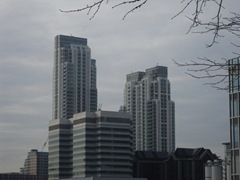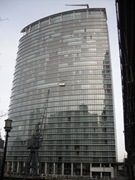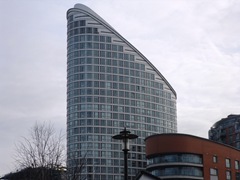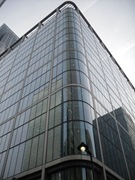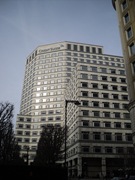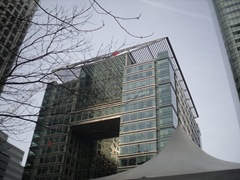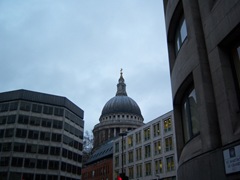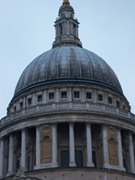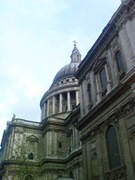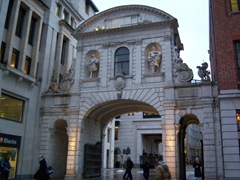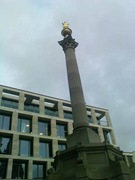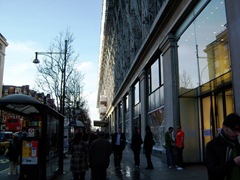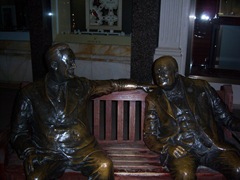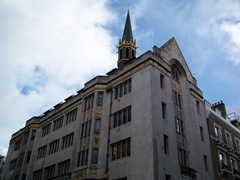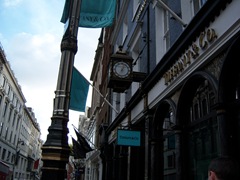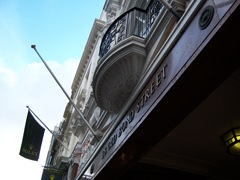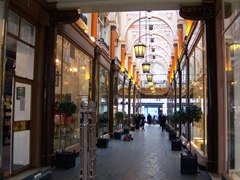Wednesday 25 February 2009
Queen Elizabeth, the Queen Mother - London Statues (1)
Saturday 21 February 2009
City of London (Tall Buildings Part 2)
Before the 1990s most of the tallest buildings in London were to be found in the 'Square Mile', within the boundaries of the City of London. These, along with some more recent additions, form a distinctive part of London's skyline.
Here are some more buildings from the "London's 50 Tallest Buildings" list.
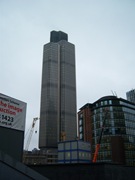 | 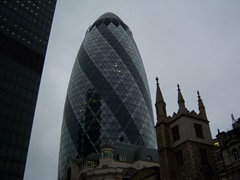 |
| Number 5
| Number 6 30 St Mary Axe, The Gherkin (180m tall with 41 floors) |
 | 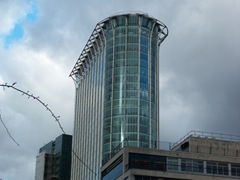 |
| Number 7 | Number 15 CityPoint (127m tall with 36 floors) |
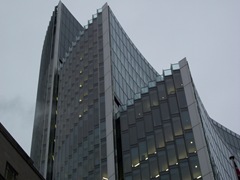 | |
| Number 16 | |
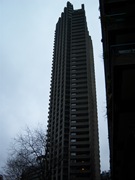  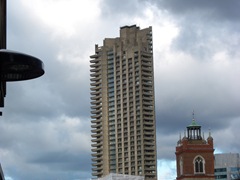 | |
| Numbers 18, 19 and 20 - Shakespeare, Lauderdale and Cromwell Towers at the Barbican (123m tall with 43 floors except Cromwell 42 floors) Until the construction of the Pan Peniunsula Towers in Docklands these were London's tallest residential towers. The three towers, along with the whole of the Barbican complex are listed buildings. | |
 |  |
| Number 23 Aviva Tower/St Helen's (118m tall with 28 floors) | Number 26 St Paul's Cathedral (111m tall) Making a surprise appearance on the tallest buildings list St Paul's is easily the oldest building on the list; illustrating who few really tall buildings there are in London at the moment. |
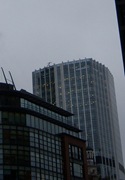 | 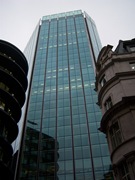 |
| Number 32 | 125 Old Broad Street, Stock Exchange Redevelopment (103m tall with 27 floors) |
 | #43 (awaiting image) |
| Number 39 | Number 43 One Angel Court (94m tall with 21 floors) |
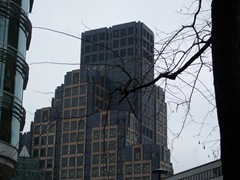 | 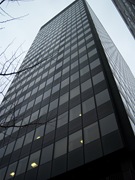 |
| Number 46 200 Aldersgate Street (91m tall with 21 floors) | Number 48 6-8 Bishopsgate (88m tall with 24 floors) |
Monday 16 February 2009
Canary Wharf (Tall Buildings Part 1)
As recently as twenty years ago there was nothing much to see in the area known as Docklands. Although much of London's wealth came originally from it's docks and import/export businesses by the middle/end of the Twentieth Century technology had overtaken the docks. New types of shipping using super-sized vessels and giant containers rendered the docks in London useless as they were too small for the new ships. The area fell into disuse and dereliction. That was until a number of initiatives to redevelop the land were put in place. Given the multiple land-owners and the fact that the area spanned some five Boroughs things were never going to be easy; but the development did get under way, and the area was regenerated into what is today Canary Wharf, Canada Water, Surrey Quays etc.
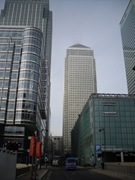 Part of this re-development meant that London got a new tallest building. The iconic One Canada Square was finished in 1991 rising about the previous tallest building Tower 42 (NatWest Tower) by some 50 metres.
Part of this re-development meant that London got a new tallest building. The iconic One Canada Square was finished in 1991 rising about the previous tallest building Tower 42 (NatWest Tower) by some 50 metres.
One Canada Square is not only the tallest building in London, but in the UK and briefly (until beaten by a building in Frankfurt) in Europe.
One Canada Square (235m tall with 50 floors)
Where there is one, more will surely follow. After ten years in lonely splendour One Canada Square was joined by the next two tallest buildings in London, one either side.
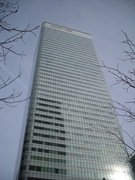 8 Canada Square (200m tall with 45 floors)
8 Canada Square (200m tall with 45 floors)
 25 Canada Square (200m tall with 45 floors)
25 Canada Square (200m tall with 45 floors)
London's tallest buildings 4 through 7 are located over in Central London (mostly the City). However numbers 8 through 11 are immediate neighbours back in Docklands.
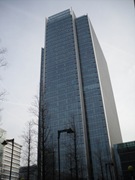 25 Bank Street (153m tall with 33 floors)
25 Bank Street (153m tall with 33 floors)
 40 Bank Street (153m tall with 33 floors)
40 Bank Street (153m tall with 33 floors)
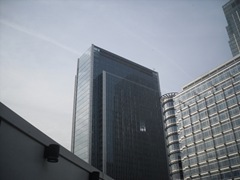 10 Upper Bank Street (151m tall with 32 floors)
10 Upper Bank Street (151m tall with 32 floors)
A little further away across the water is the building that comes it at number 12 and again at number 21. The East and West towers of the Pan Peninsula - London's tallest all residential development (although the West tower is one metre shorter than the three towers of the Barbican, the previous holders!).
Pan Peninsula's East Tower is 147m tall with 47 floors
Pan Peninsula's West Tower is 122m tall with 39 floors
Pan Peninsula shines at night, literally, when it is lit by neon lighting strips.
There are five more buildings in and around Docklands that feature in London's top 50 (well, sometimes - it depends on how you measure and what you include on the list!).
Number 28
One West India Quay (108m tall with 36 floors)
This building houses a hotel and apartments.
Number 30
Ontario Tower, New Providence Wharf (106m tall with 31 floors)
Residential use only - once again lit up at night with a blue neon ring around the ellipse.
Number 31
33 Canada Square (105m tall with 18 floors)
Linked to its immediate taller neighbour 25 Canada Square.
Number 47
One Cabot Square (89m tall with 21 floors)
Number 50
5 Canada Square (88m tall with 16 floors)
This list is correct at time of writing - but constant construction in progress means that several of these buildings will soon be knocked off London's 50 tallest building's list.
Monday 9 February 2009
St Paul's Cathedral
A cathedral has stood on this site since around the 7th Century AD and the current building is estimated to be the fifth construction on the site. The previous building was one of the many destroyed in the Great Fire (1666) and the current cathedral was one of the many buildings designed by Sir Christopher Wren.
The building we know today was based on the third proposal for the site. The first design which followed the outline of the old foundations was rejected, the second design (in the shape of a Greek cross) was also reject as too radical, and the third design, the 'warrant' design was approved; and Wren was given permission by King Charles II to make 'ornamental' changes to the approved design, amongst which was the enlargement of the dome to that which we see today.
The cathedral managed to withstand the Blitz during the Second World War, despite several times being hit by bombs; it is, therefore, a symbol of London's 'Blitz spirit' and survival abilities.
On the edge of the new Paternoster Square development is Temple Bar. Originally located on the Western edge of the City where Fleet Street becomes The Strand it was one of eight principle entries to the city (the others being: Ludgate, Aldgate, Newgate, Cripplegate, Moorgate, Bishopsgate and Aldersgate). The stone structure (by Christopher Wren) stood across Fleet Street (where it obstructed the traffic) until it was carefully dismantled and sold. It was reconstructed on a country estate (Theobald's Park) in Hertfodshire where it stood until 2003 when it was again dismantled and returned to the City (albeit not quite where it started).
Paternoster Square is an area between St Paul's and Newgate Street. It was originally developed in the 1960's for office and retail use. It was a grey, bleak development characterised by faceless blocks and a deserted square. By the late 80s/early 90s it had pretty much fallen vacant, and the last time that I walked through there it was reminiscent of something out of Clockwork Orange!
The redevelopment opened in 2004 and although the new square still has detractors it cannot be anything but an improvement on what was previously occupying the site!
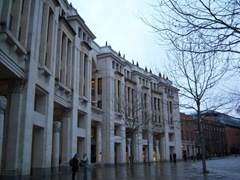
Juxon House adjacent to Temple Bar
From St Paul's it is a short walk over the Millennium Bridge to Southwark or a trip along Canon Street to London Bridge.
Sunday 1 February 2009
Oxford Street and Regent Street
Between them Oxford Street and Regent Street form the backbone of London's shopping district.
Originally designed in 1811 by John Nash and completed in 1825 Regent Street is named after the Prince Regent (later George IV). It was designed to link Carlton House (home of the Prince Regent with Regent's Park).
The original Nash buildings have long since been demolished and replaced with the buildings seen to day, and All Soul's Church at the top of Regent Street by Broadcasting House is the only Nash building to remain.
All the buildings on Regent Street are owned by the Crown Estate, and all are listed buildings.
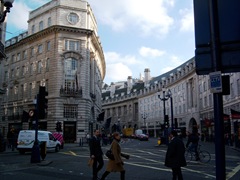
Regent Street looking South to Piccadilly Circus
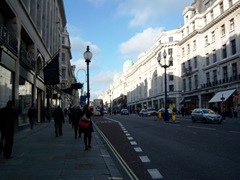
Regent Street looking North to Oxford Circus
Just off Regent Street on the East side is Carnaby Street. Originally Carnaby Street was famous in the 1960's for fashion boutiques (such as Mary Quant) and the fact that many of the famous names of the time could be seen there. There was a brief time in the late 80s and early 90s when a lot of the shops were 'tourist' type venues selling souvenirs and cheap fashion, as the area traded on its former fame. Recently the small type boutiques that made it famous have made a comeback.
Heading north from the East end of Carnaby Street takes you to Great Malborough Street. Here you will find the faux-Tudor glamour of Liberty (actually built in the 1920s) famous for its Arts and Craft styles, in particular its fabric prints.
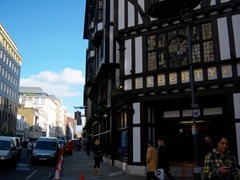
Liberty on Great Marlborough Street
Just past Liberty you find yourself on Oxford Circus. From here you can head North towards Regent's Park, East along Oxford Street to Centre Point and Tottenham Court Road or West along Oxford Street to Marble Arch.
Oxford Street is one of the major shopping thoroughfares in London. There are several major department stores as well as many smaller shops. Oxford Street is always extremely congested both with traffic (both buses and taxis) and pedestrians. Major department stores include John Lewis, Debenhams, House of Fraser and Selfridges.
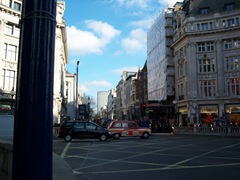
Oxford Street (East to Centre Point)
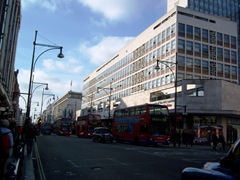
Oxford Street (West to Marble Arch)
Oxford Street is abutted by other shopping districts; Regent Street (as already mentioned) and also New Bond Street. Visitors to London are confused by the fact there is no such road as Bond Street. The nearest that you get is the underground station on Oxford Street, which confusingly doesn't even stand on New Bond Street!
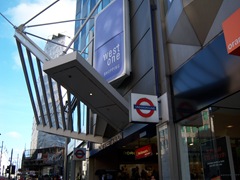
Bond Street Underground (in West One Shopping Centre)
Walking South down New Bond Street (and then Old Bond Street) will take you back to Piccadilly. The shopping here is a whole different level, and you will find many famous names such as Chanel, Prada, Gucci, DKNY and more.
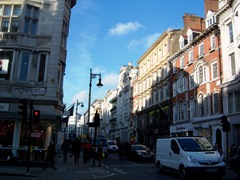
New Bond Street (looking North)
As Old Bond Street turns to New Bond Street (well, almost) you will come across this life size statue 'Allies' by Lawrence Holofcener. My photo is taken at night as during the day it is quite often joined by tourists or similar!
One of the many beautiful buildings on Old Bond Street is Number 24 which houses Atkinsons Carillion, 23 bells played by hand on occasions of celebration (such as the turning on of the Christmas lights).
Also on Old Bond Street is Tiffany and Co. This is the London branch of the New York store, famously citied by Audrey Hepburn in Breakfast at Tiffany's - where nothing bad could ever happen.
Just leading from Old Bond Street to Albermarle Street is the Royal Arcade. Smaller than most of the other Aracdes in the area it is still a beautiful example of the Victorian fashion for Arcades.
Now almost back at Piccadilly, other areas of interest near here are Green Park and St James'.


